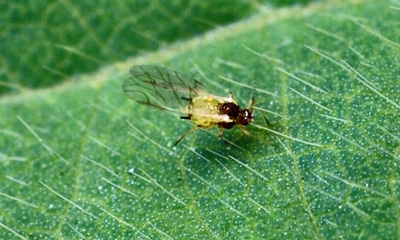July 29, 2016

Don’t be tempted to spray for soybean aphids early, advise Janel Knodel and Patrick Beauzay. Knodel is the North Dakota State University Extension entomologist. Beauzay is the NDSU Extension integrated pest management coordinator.
Their five reasons not to spray early are:
1) It’s a waste of time and money. Area university research and Extension demonstration plots have continued to validate the economic threshold for soybean aphid is 250 aphids per plant with 80% of plants infested and with aphid populations increasing.

TOO EARLY: A single soybean aphid rests on a soybean leaf. It’s too soon to spray when you find just one.
2) The insecticide will kill beneficial insects. Broad-spectrum insecticides that kill aphids will kill lady beetle and lacewing, both in the adult and larvae stages. These insects eat aphids and can keep aphid numbers in check. If you spray aphids early, before the economic threshold is reached, and the aphid population rebounds, the beneficial insects will not be present. Without predators in the field, the soybean aphid population can grow very rapidly. A second insecticide application may be required then.
3) Residual activity of foliar insecticides is relatively short-lived and will not provide protection against late-season aphid outbreaks, which typically occur from late July through mid-August in the Northern Plains. Furthermore, new leaves that have grown after an early insecticide application are not protected.
4) Repeated use of the same insecticide mode of action, especially in a single growing season, can lead to insecticide resistance in soybean aphids.
5) Using most pyrethroid insecticides (except bifenthrin) can cause spider mites to flare up, often resulting in the need to control spider mites.

SPRAY NOW: Hundreds of aphids feed on a soybean leaf. Now may be the time to spray.
“You might think that adding an inexpensive insecticide to the tank during an herbicide application is cheap insurance, but really it’s just an added input cost with no demonstrated economic benefit and potentially serious biological consequences,” Knodel says.
When to quit
Soybean is susceptible to soybean aphid damage through the R5 growth stage (beginning seed), and maybe early R6 (full seed).
“There hasn’t been a well-demonstrated economic yield benefit to spraying once we reach R6, though ongoing research is being conducted on this in the Midwest,” Beauzay says. “Once plants move through R6 and beyond, and as we move into late August and early September, aphids start moving from soybean to buckthorn.”
You May Also Like




